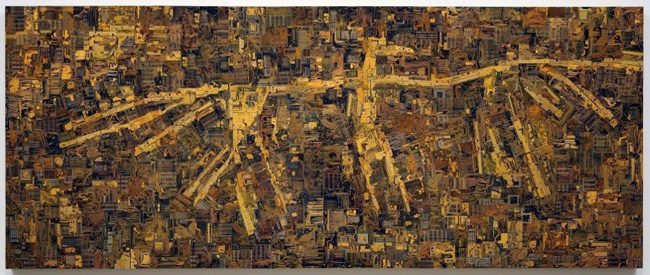Anishinaabe artists exhibit at Art Gallery of Ontario until end of November

By Barb Nahwegahbow
TORONTO – Before and After the Horizon: Anishinaabe Artists of the Great Lakes, an exhibition currently at the Art Gallery of Ontario offers a window into the world of the Anishnaabe. Toronto-based artist Bonnie Devine, a member of the Serpent River First Nation said it’s about time. “But will this be a one-off,” she said, “or will this continue?”
For more than 12,000 years, the Great Lakes region has produced a distinct culture of Anishinaabe artists and storytellers. Before and After the Horizon features works by leading modern and contemporary artists, including Norval Morrisseau, Bonnie Devine, Robert Houle and Daphne Odjig. The works are loud, they’re colourful and they’re beautiful. But most importantly, they all tell the story of the Anishinaabe.
Skillfully designed and crafted traditional objects from the mid-1800’s to the early 1900’s are also included in the exhibition. A carved wooden bowl with thunderbirds, floral beaded leggings, quilled baskets and birchbark containers were once called crafts, not art, because of their functionality. “Art always has a function,” said Andrew Hunter, curator at the AGO. “If it has no function at all, then it has no culture, it has no story.” The makers of the older traditional objects in the exhibition are largely unknown.
Before and After the Horizon is remarkable in its depth of presentation of the Anishnaabe world view. Political statements, spiritual teachings, the impact of colonization and revitalization are all on view through the art. The sheer beauty of the work leaves the viewer breathless and in awe.
Manitoulin artists are well represented in the show with Daphne Odjig, Blake Debassige, Angus Trudeau, and Carl Beam. The evocative art of Blake Debassige, M’Chigeeng First Nation artists graces the cover of the exhibition catalogue. Debassige’s work explores the teachings of the Anishinabek and One Who Lives Under the Water depicts a pair of mishibizhiig, the underwater spirits. The mishibizhiig have already overturned two boats while the fate of the third boat in the painting is still undetermined.
“We make our objects for aesthetic purposes. They’re beautiful,” said Bonnie Devine, “but it’s never the only reason we make art. We make our art to tell a story, or to carry a meaning, a sentiment, a piece of history.”
Devine was invited by the AGO to create what curator Andrew Hunter calls an intervention. “The artist is thinking about everything else that’s going on around their project, intervening into an existing narrative,” said Hunter.
Devine’s project was a pre-Confederation map of Canada that has been displayed at the AGO since 2008. Devine expanded the map to include the Great Lakes which she envisioned as five spirit creatures – Bison, Otter, Turtle, Mishepishu (Underwater Panther) and Nanibush as Rabbit. The piece is titled Battle for the Woodlands.
One of the things the exhibition has brought about, said Andrew Hunter, is a realization that the AGO has to be consistently engaged, “with the complex and difficult dialogue between the colonizer and the colonized, between the newcomer and the established cultures.”
Before and After the Horizon is on view until November 26.


